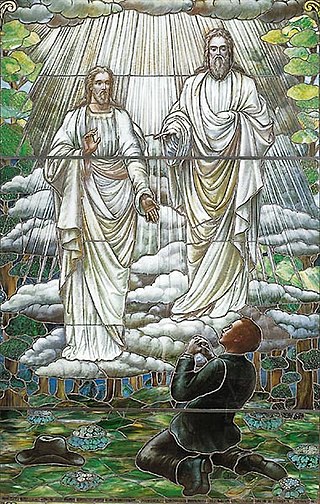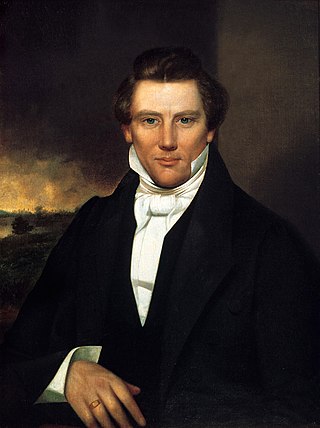
The Book of Mormon is a religious text of the Latter Day Saint movement, first published in 1830 by Joseph Smith as The Book of Mormon: An Account Written by the Hand of Mormon upon Plates Taken from the Plates of Nephi.

The Mountain Meadows Massacre was a series of attacks during the Utah War that resulted in the mass murder of at least 120 members of the Baker–Fancher wagon train. The massacre occurred in the southern Utah Territory at Mountain Meadows, and was perpetrated by settlers from the Church of Jesus Christ of Latter-day Saints involved with the Utah Territorial Militia who recruited and were aided by some Southern Paiute Native Americans. The wagon train, made up mostly of immigrant families from Arkansas, was bound for California, traveling on the Old Spanish Trail that passed through the Territory.

The First Vision refers to a theophany which Latter Day Saints believe Joseph Smith experienced in the early 1820s, in a wooded area in Manchester, New York, called the Sacred Grove. Smith described it as a vision in which he received instruction from God the Father and Jesus Christ.

The Book of Abraham is a religious text of the Latter Day Saint movement, first published in 1842 by Joseph Smith. Smith said the book was a translation from several Egyptian scrolls discovered in the early 19th century during an archeological expedition by Antonio Lebolo, and purchased by members of the Church of Jesus Christ of Latter-day Saints from a traveling mummy exhibition on July 3, 1835. According to Smith, the book was "a translation of some ancient records... purporting to be the writings of Abraham, while he was in Egypt, called the Book of Abraham, written by his own hand, upon papyrus". The Book of Abraham is about Abraham's early life, his travels to Canaan and Egypt, and his vision of the cosmos and its creation.

In orthodox Mormonism, the term God generally refers to the biblical God the Father, whom Latter Day Saints also refer to as Elohim or Heavenly Father, while the term Godhead refers to a council of three distinct divine persons consisting of God the Father, Jesus Christ, and the Holy Ghost. However, in Latter Day Saint theology the term God may also refer to, in some contexts, the Godhead as a whole or to each member individually.

The Mormon pioneers were members of the Church of Jesus Christ of Latter-day Saints, also known as Latter-day Saints, who migrated beginning in the mid-1840s until the late-1860s across the United States from the Midwest to the Salt Lake Valley in what is today the U.S. state of Utah. At the time of the planning of the exodus in 1846, the territory comprising present-day Utah was part of the Republic of Mexico, with which the U.S. soon went to war over a border dispute left unresolved after the annexation of Texas. The Salt Lake Valley became American territory as a result of the Treaty of Guadalupe Hidalgo, which ended the war.

David Whitmer was an early leader of the Latter Day Saint Movement and one of the Three Witnesses to the gold plates of the Book of Mormon. Whitmer later distanced himself from Joseph Smith and was excommunicated from the church in 1838, but continued to affirm his testimony of the Book of Mormon. He was the most interviewed Book of Mormon witness.

The Baker–Fancher party was a group of American western emigrants from Marion, Crawford, Carroll, and Johnson counties in Arkansas, who departed Carroll County in April 1857 and "were attacked by the Mormons near the rim of the Great Basin, and about fifty miles from Cedar City, in Utah Territory, and that all of the emigrants, with the exception of 17 children, were then and there massacred and murdered" in the Mountain Meadows massacre. Sources estimate that between 120 and 140 men, women and children were killed on September 11, 1857, at Mountain Meadows, a rest stop on the Old Spanish Trail, in the Utah Territory. Some children of up to six years old were taken in by the Mormon families in Southern Utah, presumably because they had been judged to be too young to tell others about the massacre.
The history of the Latter Day Saint movement includes numerous instances of violence committed both by and against adherents. Mormons faced significant persecution in the early 19th century, including instances of forced displacement and mob violence in Ohio, Missouri, and Illinois. Notably, the founder of Mormonism, Joseph Smith, was shot and killed alongside his brother, Hyrum Smith, in Carthage, Illinois in 1844, while Smith was in jail awaiting trial on charges of treason and inciting a riot.
In the Book of Mormon, Zenock is a prophet who predates the events of the book's main plot and whose prophecies and statements are recorded upon brass plates possessed by the Nephites. Nephite prophets quote or paraphrase Zenock several times in the course of the narrative.
Although the Mountain Meadows massacre was covered to some extent in the media during the 1850s, its first period of intense nationwide publicity began around 1872. This was after investigators obtained the confession of Philip Klingensmith, a Mormon bishop at the time of the massacre and a private in the Utah militia. National newspapers also covered the John D. Lee trials closely from 1874 to 1876, and his execution in 1877 was widely publicized. The first detailed work using modern historical methods was published in 1950, and the massacre has been the subject of several historical works since that time.

The Book of Abraham is a work produced between 1835 and 1842 by the Latter Day Saints (LDS) movement founder Joseph Smith that he said was based on Egyptian papyri purchased from a traveling mummy exhibition. According to Smith, the book was "a translation of some ancient records ... purporting to be the writings of Abraham, while he was in Egypt, called the Book of Abraham, written by his own hand, upon papyrus". The work was first published in 1842 and today is a canonical part of the Pearl of Great Price. Since its printing, the Book of Abraham has been a source of controversy. Numerous non-LDS Egyptologists, beginning in the mid-19th century, have heavily criticized Joseph Smith's translation and explanations of the facsimiles, unanimously concluding that his interpretations are inaccurate. They have also asserted that missing portions of the facsimiles were reconstructed incorrectly by Smith.

The Joseph Smith Hypocephalus was a papyrus fragment, part of a larger collection of papyri known as the Joseph Smith Papyri. The papyri are Egyptian funerary papyrus fragments from ancient Thebes dated between 300 and 100 BC which, along with four mummies, were once owned by Joseph Smith, the founder of the Latter Day Saint movement. The name of the owner Sheshonq is written in the hieroglyphic text on the hypocephalus. Smith purchased the mummies and papyrus documents from a traveling exhibitor in Kirtland, Ohio in 1835. Smith said that the hypocephalus contained records of the ancient patriarch Abraham. In 1842, Smith published the first part of the Book of Abraham, which he said was an inspired translation from the papyri. The consensus among both Mormon and non-Mormon scholars is that the characters on the surviving papyrus fragments do not match Smith's translation.

The standard works of Mormonism—the largest denomination of which is the Church of Jesus Christ of Latter-day Saints —have been the subject of various criticisms. Latter-day Saints believe the Book of Mormon is a sacred text with the same divine authority as the Bible; both are considered complementary to each other. Other Mormon sacred texts include the Pearl of Great Price and Doctrine and Covenants, which are also recognized as scripture. Religious and scholarly critics outside Mormonism have disputed Mormonism's unique scriptures, questioning the traditional narrative of how these books came to light and the extent to which they describe actual events. Critics cite research in history, archeology, and other disciplines to support their contentions.

This is a chronology of Mormonism. In the late 1820s, Joseph Smith, founder of the Latter Day Saint movement, announced that an angel had given him a set of golden plates engraved with a chronicle of ancient American peoples, which he had a unique gift to translate. In 1830, he published the resulting narratives as the Book of Mormon and founded the Church of Christ in western New York, claiming it to be a restoration of early Christianity.

Joseph Smith, Jr. was the leader and founder of the Latter Day Saint movement. Being Continuationist, the movement is characterized by a belief that the miracles, visions, prophecies, and revelations attributed to the biblical era continue still today, contingent upon need and the faith of those involved. This belief is based both upon scriptural teachings in the Bible and Book of Mormon and upon accounts of such miracles performed by Smith.
Thomas Brown Holmes Stenhouse was an early Mormon pioneer and missionary who later became a Godbeite and with his wife, Fanny Stenhouse, became a vocal opponent of the Church of Jesus Christ of Latter-day Saints.

The Church of Jesus Christ of Latter-day Saints has had a presence in Italy since 1850.
This is a bibliography of literature treating the topic of criticism of Mormonism, sorted by alphabetical order of titles.









